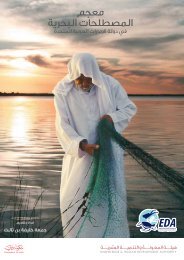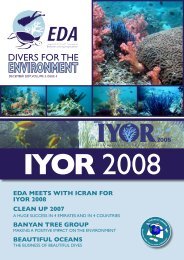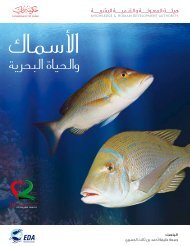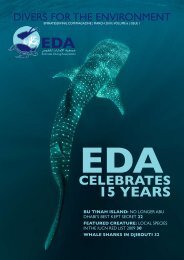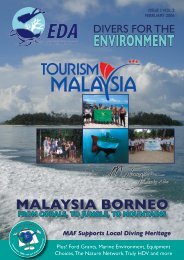Download - Emirates Diving Association
Download - Emirates Diving Association
Download - Emirates Diving Association
Create successful ePaper yourself
Turn your PDF publications into a flip-book with our unique Google optimized e-Paper software.
CORAL NEWS<br />
records of oceanographic and climate variability.”<br />
An international team of more than 40 scientists<br />
and students – partners from multiple federal<br />
agencies and academic institutions – located<br />
mostly on shore, participated in the expedition’s<br />
first leg, receiving data and live video from the<br />
ship via telepresence-technology, using satellite<br />
and Internet pathways. The science team<br />
included several scientists at sea and others in<br />
Washington DC, 12 US states and two nations.<br />
Scientists on the expedition’s July leg mapped<br />
7,209 square kilometers of seafloor as they<br />
explored areas between 560 meters (1,837<br />
feet) and 2,135 meters (7,005 feet) deep,<br />
in and between Block, Alvin, Atlantis, Veatch<br />
and Hydrographer canyons. The second leg<br />
is exploring Welker, Oceanographer, Lydonia,<br />
Nygren and Heezen canyons as well as Mytilus<br />
Seamount, one of the easternmost seamounts<br />
along the submerged northeast New England<br />
Seamount Chain within the US Exclusive<br />
Economic Zone. Very little information exists<br />
for these areas. Scientists on both expedition<br />
legs are obtaining valuable data using the<br />
latest technologies including state-of-the-art<br />
multibeam sonar and NOAA’s new 6,000-meter<br />
ROV, Deep Discoverer, coupled with the Seirios<br />
camera sled and lighting platform.<br />
NOAA Fisheries’ Deep-Sea Coral Research<br />
and Technology Program and the Northeast<br />
Regional planning team contributed scientific<br />
and financial support to this expedition. The<br />
program provides scientific information needed<br />
by NOAA and regional management councils<br />
to conserve and manage the nation’s deep-sea<br />
coral ecosystems.<br />
NOAA’s Ocean Exploration Program is the<br />
only federal program dedicated to systematic<br />
exploration of the planet’s largely unknown<br />
ocean. NOAA Ship Okeanos Explorer is<br />
operated, managed and maintained by NOAA’s<br />
Office of Marine and Aviation Operations which<br />
includes commissioned officers of the NOAA<br />
Corps and civilian wage mariners. NOAA’s<br />
Office of Ocean Exploration and Research<br />
operates, manages and maintains the cuttingedge<br />
ocean exploration systems on the vessel<br />
and ashore.<br />
NOAA’s mission is to understand and predict<br />
changes in the Earth’s environment, from the<br />
depths of the ocean to the surface of the sun,<br />
and to conserve and manage our coastal and<br />
marine resources.<br />
ROV Deep Discoverer investigates the geomorphology<br />
of Block Canyon.<br />
What are Corals?<br />
Feature NOAA<br />
When corals are mentioned, most people immediately think about clear,<br />
warm tropical seas and fish-filled reefs. In fact, the stony, shallow-water<br />
corals – the kind that build reefs – are only one type of coral. There are also<br />
soft corals and deep water corals that live in dark cold waters.<br />
Almost all corals are colonial organisms. This<br />
means that they are composed of hundreds<br />
to hundreds of thousands of individual animals,<br />
called polyps. Each polyp has a stomach that<br />
opens at only one end. This opening, called the<br />
mouth, is surrounded by a circle of tentacles.<br />
The polyp uses these tentacles for defense, to<br />
capture small animals for food, and to clear<br />
away debris. Food enters the stomach through<br />
the mouth. After the food is consumed, waste<br />
products are expelled through the same<br />
opening.<br />
Most corals are made up of hundreds of<br />
thousands of individual polyps like this one<br />
below.<br />
Many stony coral polyps range in size from one<br />
to three millimeters in diameter. Anatomically<br />
simple organisms, much of the polyp’s body<br />
is taken up by a stomach filled with digestive<br />
filaments. Open at only one end, the polyp<br />
takes in food and expels waste through<br />
its mouth. A ring of tentacles surrounding<br />
the mouth aids in capturing food, expelling<br />
waste and clearing away debris. Most food is<br />
captured with the help of special stinging cells<br />
called nematocysts which are inside the polyp’<br />
outer tissues, which is called the epidermis.<br />
Calcium carbonate is secreted by reef-building<br />
polyps and forms a protective cup called a<br />
calyx within which the polyps sits. The base of<br />
the calyx upon which the polyp sits is called<br />
the basal plate. The walls surrounding the calyx<br />
are called the theca. The coenosarc is a thin<br />
band of living tissue that connect individual<br />
polyps to one another and help make it a<br />
colonial organism.<br />
Most corals feed at night. To capture their food,<br />
corals use stinging cells called nematocysts.<br />
These cells are located in the coral polyp’s<br />
tentacles and outer tissues. If you’ve ever<br />
been “stung” by a jellyfish, you’ve encountered<br />
nematocysts.<br />
The diagram above shows the anatomy of a<br />
nematocyst cell and its “firing” sequence, from<br />
left to right. On the far left is a nematocyst<br />
inside its cellular capsule. The cell’s thread is<br />
coiled under pressure and wrapped around<br />
a stinging barb. When potential prey makes<br />
contact with the tentacles of a polyp, the<br />
nematocyst cell is stimulated. This causes a<br />
flap of tissue covering the nematocyst – the<br />
operculum – to fly open.<br />
The middle image shows the open operculum,<br />
the rapidly uncoiling thread and the emerging<br />
barb. On the far right is the fully extended cell.<br />
The barbs at the end of the nematocyst are<br />
designed to stick into the polyp’s victim and<br />
inject a poisonous liquid. When subdued, the<br />
polyp’s tentacles move the prey toward its<br />
mouth and the nematocysts recoil back into<br />
their capsules.<br />
Nematocysts are capable of delivering<br />
powerful, often lethal, toxins, and are essential<br />
in capturing prey. A coral’s prey ranges in<br />
size from nearly microscopic animals called<br />
zooplankton to small fish, depending on the<br />
size of the coral polyps.<br />
In addition to capturing zooplankton and<br />
larger animals with their tentacles, many corals<br />
also collect fine organic particles in mucous<br />
film and strands, which they then draw into<br />
their mouths.<br />
REEF CHECK<br />
REEF CHECK MALAYSIA’S ROCKIN’ 4 THE REEFS 2013<br />
FEATURE AND PHOTOGPAPHY Reef Check Malaysia<br />
In April, Reef Check Malaysia (RCM) and the<br />
Environmental Education Alliance of South East<br />
Asia (EEASEA), with support from Ecoknights<br />
and Go! International, organized Rockin’ 4 the<br />
Reefs 2013 (R4R). R4R is an annual music, arts<br />
and cultural festival to raise awareness and<br />
funds for local environmental education and<br />
conservation initiatives. It is part of the annual<br />
Rockin for the Environment series that has<br />
“rocked” in the past for sun bears, dugongs,<br />
orangutans, tigers and turtles.<br />
The two-week long R4R campaign was<br />
launched at Publika, a local shopping mall, with<br />
performances by school groups from SK Bukit<br />
Damansara, SMK Puterijaya, SK Brickfields,<br />
International School KL and the Alice Smith<br />
This May, Reef Check Dominican Republic<br />
(RCDR) launched the National Coral Reef<br />
Initiative. In order to reduce local impacts,<br />
restore affected areas and promote sustainable<br />
use of marine and coastal resources, RCDR<br />
announced the implementation of strategic<br />
alliances with key partner institutions in<br />
parts of the country with tourist or fisheries<br />
importance to develop regional coral reefs<br />
initiatives, that all combined, constitute the<br />
national coral reef initiative. The National Coral<br />
Reef Initiative seeks to institutionalize local or<br />
regional efforts that would in turn follow the<br />
global guidelines of the International Coral<br />
Reef Initiative (ICRI).<br />
This initiative aims to provide training for<br />
different groups of users, both to raise<br />
awareness and to enable local communities to<br />
verify the status and progress or deterioration<br />
of marine ecosystems. These studies will indicate<br />
the location and size of potential protected<br />
areas, both inside and outside the national<br />
system of protected areas, and will involve<br />
local communities in sustainable use activities<br />
in these areas. These natural attractions, in turn,<br />
will benefit the local communities.<br />
Partners supporting this initiative will<br />
create a locally funded independent marine<br />
conservation area from voluntary user fees<br />
School, as well as performances from local<br />
artists Az Samad, Poova and Bihzhu. In addition<br />
to the performances, 17 non-governmental<br />
organizations and businesses that promote<br />
green living showcased their work and<br />
products at the R4R bazaar.<br />
After the launch, RCM continued to visit<br />
schools, universities and companies under<br />
the banner of R4R, conducting talks to raise<br />
awareness for coral reefs and problems they<br />
are facing. The talks reached out to about<br />
3,365 school students and close to 100 staff<br />
from various companies around Kuala Lumpur.<br />
In conjunction with R4R, RCM also launched<br />
its “Adopt a Reef” and “Adopt a Reef Critter”<br />
and will be responsible for active members<br />
and for following the guidelines of sustainable<br />
use of coastal marine resources through local<br />
conservation programs.<br />
Currently the National Coral Reef Initiative has<br />
launched activities in Las Terrenas with Turtle<br />
Dive School Dive Center, Coral Point Divers in<br />
Bayahibe, and Tasha Gough in Cabarete, Sosua<br />
and Punta Rucia. Montecristi and Las Galeras<br />
will be coming on board soon.<br />
To be part of this initiative, please contact<br />
RCDR at 809-227-4409, info@reefcheckdr.<br />
org, or visitwww.reefcheckdr.org.<br />
In recognition of its conservation efforts,<br />
RCDR was recently awarded the 2013<br />
ATABEY Conservation Award by the Centro<br />
de Innovación ATABEY (the ATABEY Center<br />
of Innovation). Located in the Dominican<br />
Republic, the Atabey Awards is an annual<br />
event that identifies national efforts related to<br />
environmental protection, coupled with local<br />
economic development and the promotion of<br />
social cohesion. The award aims to recognize<br />
the work of individuals or institutions that<br />
perform actions or relevant works to the<br />
benefit of sustainable development in the<br />
communities where they are located. At the<br />
same time, the award serves as a platform to<br />
programs, allowing individuals and companies<br />
to contribute to coral reef conservation.<br />
For RM 1000, an individual or company can<br />
support the cost of conducting a coral reef<br />
survey. Alternatively, an individual can also<br />
symbolically adopt one of 3 reef critters for<br />
RM 20, RM 50 and RM 100. This will help fund<br />
coral reef education programs.<br />
R4R has raised nearly RM 10,000 for local<br />
environmental education and conservation,<br />
and has reached out through various media<br />
to educate an estimated 20,000 people about<br />
coral reefs. The Rockin 4 the Environment<br />
series will continue in 2014 and will hope<br />
to reach out to more individuals and spread<br />
awareness for conservation initiatives.<br />
REEF CHECK DOMINICAN REPUBLIC LAUNCHES NATIONAL CORAL REEF INITIATIVE<br />
FEATURE AND PHOTOGPAPHY Reef Check Dominican Republic<br />
showcase what is being done in the Dominican<br />
Republic in terms of sustainable design,<br />
environmental protection, alternative energy<br />
technologies, organic agriculture, among other<br />
related topics.<br />
16 DIVERS FOR THE ENVIRONMENT, SEPTEMBER 2013<br />
SEPTEMBER 2013, DIVERS FOR THE ENVIRONMENT 17




